Ubirr, forty two kilometers from Jabiru, is in the East Alligator region of Kakadu National Park, and borders on Arnhem Land. This is where I had the most profoundly moving experience of my life. Here’s my story of this experience.
Ubirr is the traditional lands of the Bunidj, Manilagarr, Murrwan and Mandjurlgunj people. Our guide, a young Aboriginal man who lives on his traditional land, quietly met us at the beginning of the track and so began this deeply moving experience for me, my husband and adult son. What knowledge, humility, respect for his country and people, what patience in dealing with thoughtless questions this young man displayed. His dignity and maturity was an example to all.
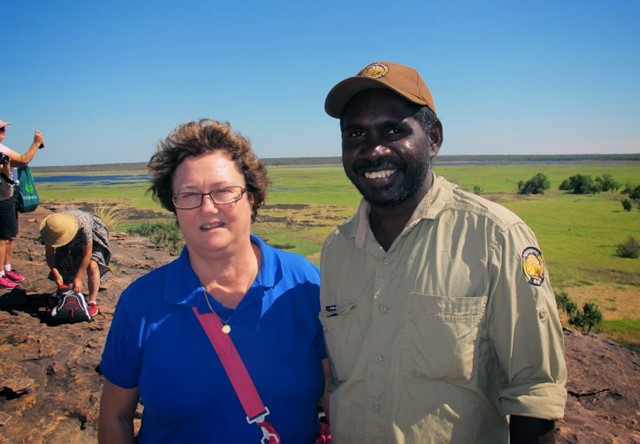
At the end of his presentation when I asked if I could take his photo he said that he wanted one with me. Although I prefer to be the other side of the camera I could hardly refuse. I show it now, at the beginning of my story because this young man had a profound effect on me that day.
It was with pride that he explained that his clan was represented on the Land Council that was ensuring that his country was being respectfully cared for and being shared with all who came to explore it and to learn about its ways. He said that one of his clan was a member of this Council and that one day his own turn would come to take on that responsibility. I am sure that he will do a great job when his time comes.
What a spellbinding story teller he was! Most of the large group were captivated with the images he evoked with his soft, thoughtful language and careful indication of where to look to see the characters he was describing. The stories he told were of a cautionary nature, illustrating why the people needed to abide by the clan laws and what would happen to them if they didn’t. As he talked I realised how important these laws were for the survival of the families who were reliant on nature to provide for their every need as well as to guard against the dangers their country held for them.
One area was an outdoor classroom area where children were taught the laws of their clan and the land.
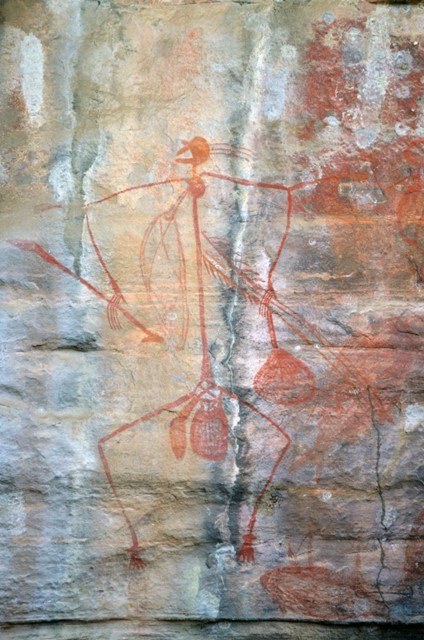
The photo above is a painting of Mabayu. You can see his spear, dilly bag and spear thrower. His story is a cautionary one about the consequences of sneakily taking something that does not belong to you and it was told something like this. I will try to tell it as it was told to us.
One day Mabayu was fishing near the East Alligator river. It was a good day. There were many fish and as he caught each one, he placed it carefully on a pile on the river bank. A greedy person was watching this and, when Mabayu was not looking she crept up and stole all the fish. Mabayu came up from the river and saw his fish were gone. He went looking for them and smelled them cooking on a fire in a cave. He hid and watched all the people eating his fish. That night he blocked the entrance to the cave with a big stone and all the people were shut inside. No one could get out. Not one. So, behave properly and do good behaviour. Don’t take anyone else’s fish.
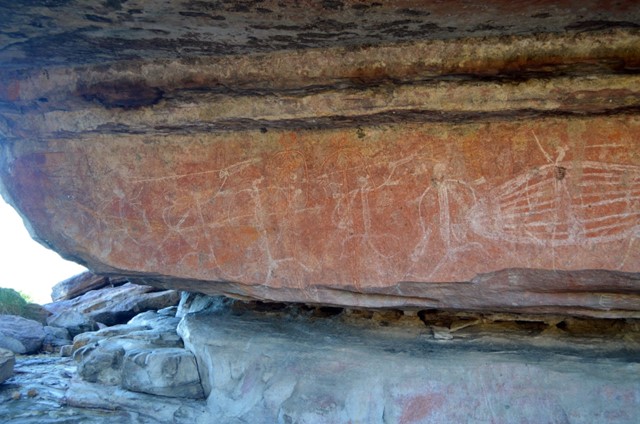
Then there was the story of the girl who ate Barramundi at the wrong time, breaking the traditional laws. When she was punished too severely there was a battle between the clans and many, many people died. So, don’t do the wrong thing or many other innocent people may suffer your consequences. A common punishment was to be speared in the leg. This would be life threatening not only because of infection but because the person would not be able to move around to be safe from harmful things or to find food and water.
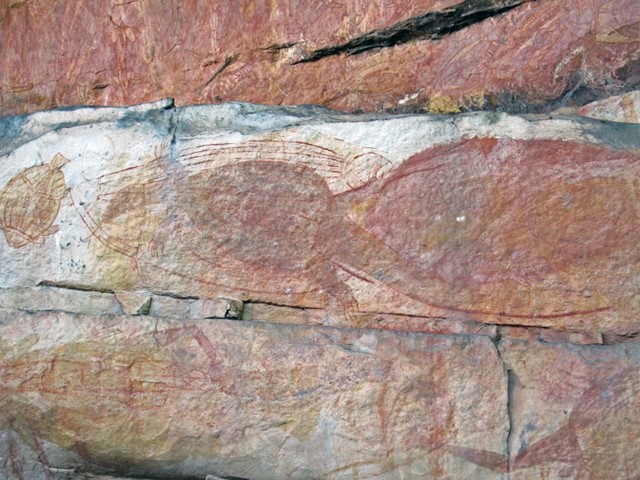
Then there were the two Mamarrgarn Sisters who were playing string games down by the river. One of them stood in the water at the mouth of the East Alligator River. She knew how to turn herself into a crocodile, so she did. Then she turned herself back to a sister.
Her sister was watching and she asked, “Can you show me how to do that?”
So they went to a fresh water spring and the second sister learned how to turn into a crocodile. Then they both changed into a saltwater crocodile and stayed like that. Nowadays there are palms around that spring that grew from the sister’s teeth which they pulled from their mouths and planted. As crocodiles, the sisters always know where their food is because of the large ridge scales on their backs. They are special sensory powers that tell where dinner is, even under water.
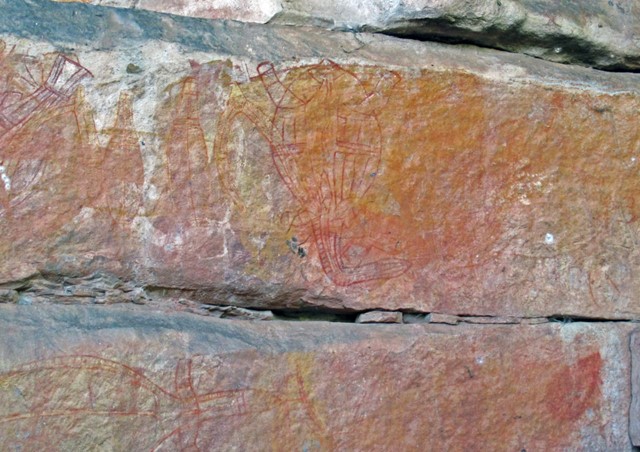
Another story that held us spell bound until the final words was that of the long necked turtle and the echidna. Here it is, again told as closely as possible as it was to us.
In our Dreamtime a long necked turtle and an echidna were good friends who lived together. They hunted together and shared their food. The echidna had a little one, a baby. One day they ran out of food so the echidna told the turtle to stay and keep the little one safe while she went hunting further away. So she went and the turtle stayed with the little one.
The echidna was gone a long, long time and the turtle was very hungry. After a while he was so hungry he ate the little one. Then the echidna came back with some food.
“Where is my little one?” she asked.
“I was so hungry that I ate it,” said the turtle.
The echidna was so angry that she went to get stones to throw at the turtle. The turtle got spear grass and threw it at the echidna. They had a big fight. After that the stones turned into a shell on the turtle’s back and the spear grass turned into spines on the echidna.
Then the turtle told the echidna, “I will go and live in the billabong and never see you again.”
The echidna said, “I will go and live up in the escarpment and never see you again.”
They did that. Now, when we eat turtle, we find the little echidna’s bones in the turtle’s throat.
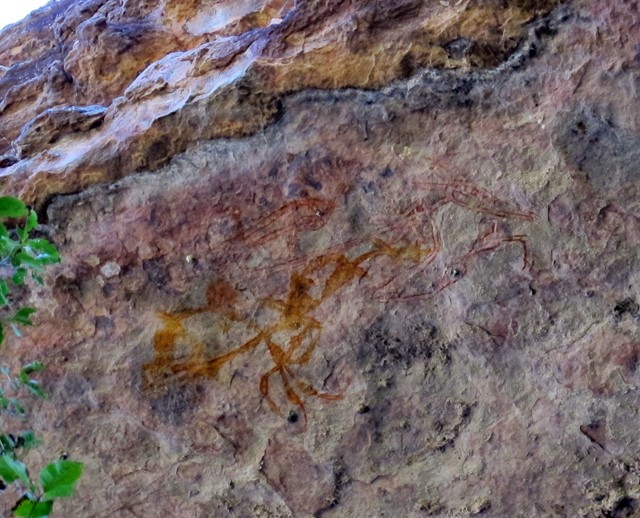
Some of the paintings are high on the escarpment. The Mimi Spirits were Dreamtime ancestors who were the first to draw rock paintings and taught the people. Some of them entered the rock as paintings themselves and the places where this happened are sacred places, visited only by a few permitted people.
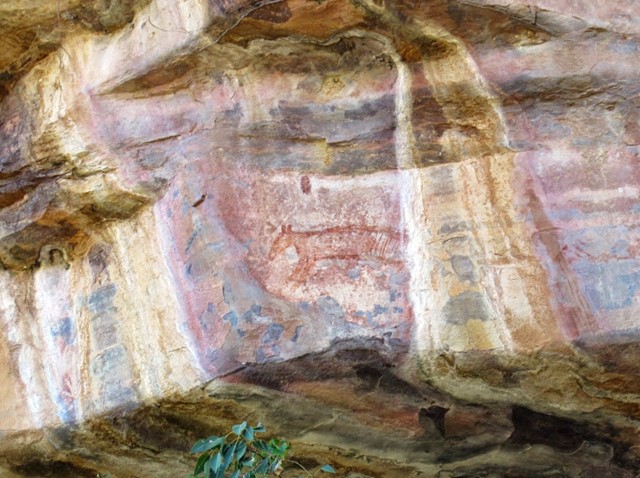
Other lofty paintings record now extinct animals that must have been common to the area. The Tassie Tiger is one of these.
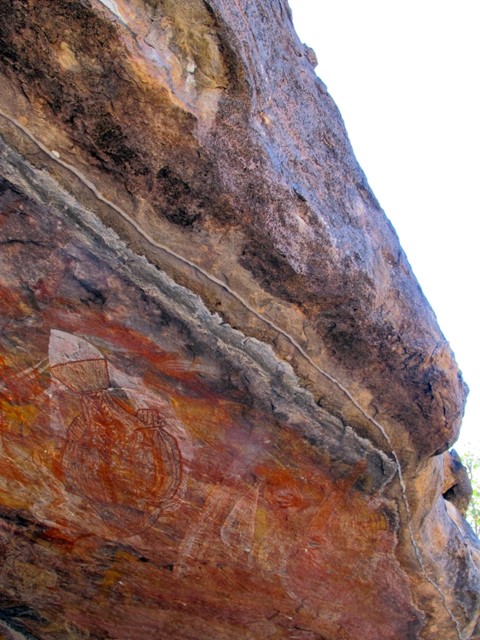
Over the centuries the weather elements have assaulted the paintings with some visibly losing colours. The ridge line visible in the above photo is a resin ridge that guides rain water along it and down the side of the rock face instead of falling down over the paintings, destroying them.
Our guide told us that only special people within his clan were allowed to do the painting, each one permitted to do only a certain part. He himself is permitted to do only the lines using a thick brush, not the finer details. He picked up pieces of rock that could be crumbled to make a fine powder, sometimes reddish and sometimes yellow. “This here rock powder is then mixed with a resin from a plant so that it sticks to the rock for a long, long time,” he said.
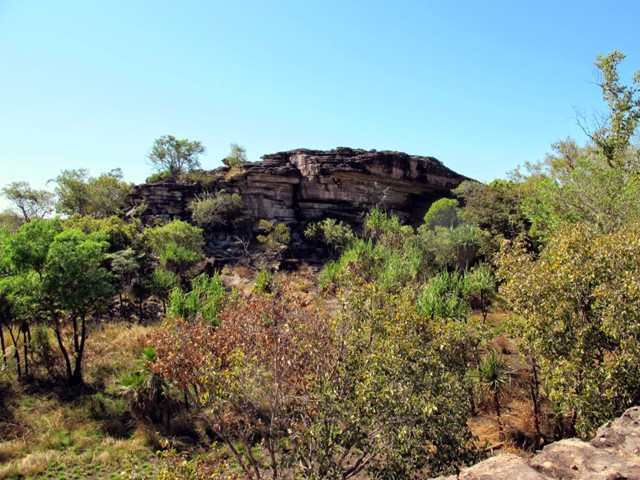
Storytelling finished, our guide had us clamber up some steepish rocks to a small plateau that allowed us to look back at the caves where we had had the privilege of seeing the paintings and hearing their stories.
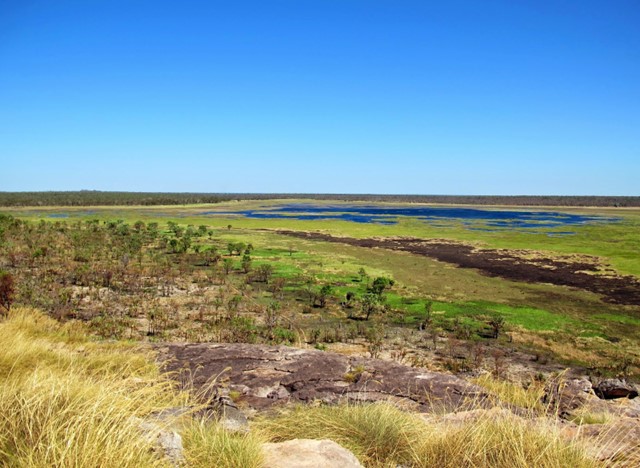
After telling us that in the wet seasons of Gudjewg and Banggerreng, he travels around the area below by boat, our young guide left us but not before we were thanked for visiting his country and for listening to the stories of his people. As he was saying his last words, I was pleased to see my son make his way down the rocks to shake this awesome young man’s hand and even more pleased to see everyone else do the same. Our time with him was so precious that the usual applause would have been way less than adequate or respectful.